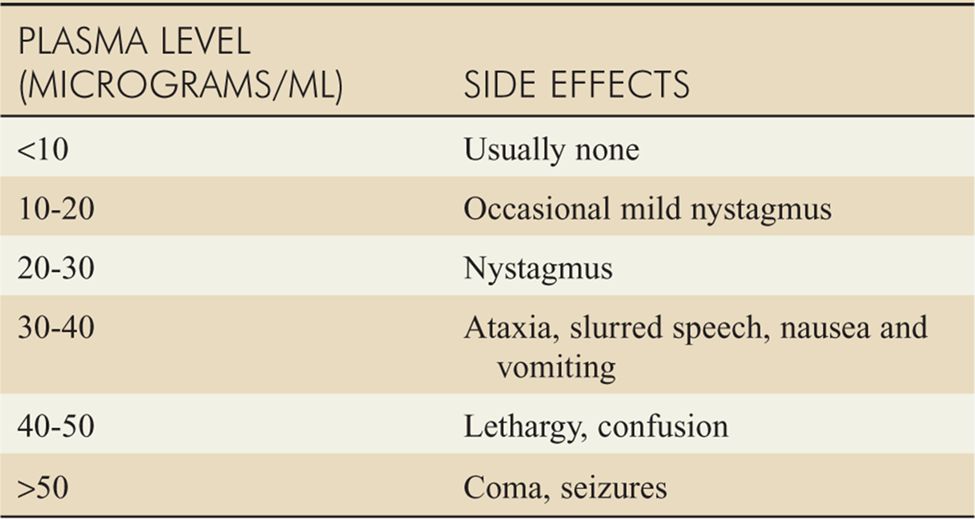The nurse is preparing to administer phenytoin to a patient who has a seizure disorder. The patient appears drowsy, and the nurse notes that the last random serum drug level was 18 mcg/mL. What action will the nurse take?
Administer the dose since the patient is not toxic
Contact the provider to discuss decreasing the phenytoin dose
Give the drug and monitor closely for adverse effects
Report drug toxicity to the providers
The Correct Answer is D
A. Administer the dose since the patient is not toxic.
This is not the appropriate action. With a drowsy patient and a high serum phenytoin level, there is a concern for toxicity. Administering the next dose could worsen the toxicity.
B. Contact the provider to discuss decreasing the phenytoin dose.
While adjusting the dose may be a consideration, the immediate action should be to withhold the next dose and report the elevated level to the healthcare provider. The provider can then determine the appropriate course of action.
C. Give the drug and monitor closely for adverse effects.
Giving the drug without further intervention is not appropriate when there are signs of potential toxicity, such as drowsiness. Monitoring alone is not sufficient in this case.
D. Report drug toxicity to the providers.
This is the correct choice. With a drowsy patient and a serum phenytoin level of 18 mcg/mL, which is considered high, reporting the drug toxicity to the healthcare provider is the immediate and appropriate action. The provider can then determine the next steps, such as adjusting the dose or ordering additional tests.

Nursing Test Bank
Naxlex Comprehensive Predictor Exams
Related Questions
Correct Answer is C
Explanation
A. "You will need to take an anticonvulsant of some type for your lifetime."
This statement may be accurate for some individuals with chronic or recurrent seizure disorders, but it is a generalization. The duration of anticonvulsant therapy varies from person to person, and some individuals may eventually be able to discontinue medication under the guidance of their healthcare provider.
B. "This medication should be taken until you haven't had a seizure for a month."
While seizure control is a factor in determining the duration of treatment, setting a specific timeframe (e.g., one month) may not be applicable to everyone. The decision to continue or discontinue anticonvulsant therapy is usually individualized and based on various factors, including the type of seizure disorder and the individual's response to treatment.
C. "Seizures are unpredictable and so is the duration of the treatment."
This is the best response. It acknowledges the variability in seizure disorders and the individualized nature of treatment duration. Seizure management is often an ongoing process that requires monitoring and adjustments based on the person's specific circumstances.
D. "You will only need to take it for a short period of time because anticonvulsants will cure the seizure disorder."
Anticonvulsants are typically used to manage and control seizures rather than cure the underlying seizure disorder. While some individuals may experience a period of seizure freedom and be able to discontinue medication, this is not true for everyone. The duration of treatment varies, and some individuals may require long-term or even lifelong therapy.
Correct Answer is ["C","D","E"]
Explanation
A. Decreasing physical activity: This is not a helpful intervention for preventing constipation. Physical activity, such as regular exercise, is beneficial for promoting bowel regularity.
B. Decreasing fluid intake: This is not a helpful intervention for preventing constipation. An adequate fluid intake is crucial for maintaining bowel regularity.
C. Nutritional diet high in fiber: This is a correct choice. Consuming a diet rich in fiber helps add bulk to the stool and promotes regular bowel movements, preventing constipation.
D. Increasing fluid intake: This is a correct choice. Staying well-hydrated is important for maintaining bowel regularity. Fluids help soften the stool and aid in its passage.
E. Increasing daily activity: This is a correct choice. Regular physical activity helps stimulate bowel movements and can contribute to preventing constipation.
Whether you are a student looking to ace your exams or a practicing nurse seeking to enhance your expertise , our nursing education contents will empower you with the confidence and competence to make a difference in the lives of patients and become a respected leader in the healthcare field.
Visit Naxlex, invest in your future and unlock endless possibilities with our unparalleled nursing education contents today
Report Wrong Answer on the Current Question
Do you disagree with the answer? If yes, what is your expected answer? Explain.
Kindly be descriptive with the issue you are facing.
